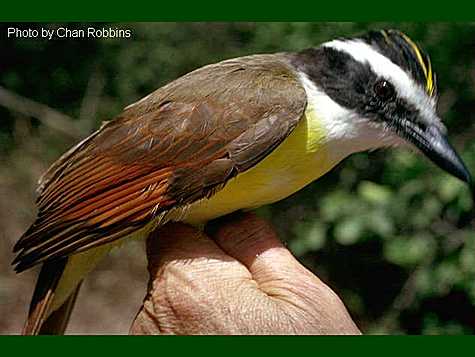
If you’ve been following the Sightings section, you know we’ve been seeing and hearing a very rare bird for this area. It is the Great Kiskadee. A bird of the Valley, you know the Valley in far South Texas where Brownsville, Harlingen, McAllen, and other Valley cities are. Whenever we get a photograph of this bird, we’ll be sure to post it for all to see. In the meantime, the link above will take you to a site with pictures and the bird’s call. I was the first to hear the bird while out birding the Cedar Creek area in NE Abilene on Thursday, Sept. 14. Then the bird put in an appearance and as soon as I could get my lower jaw off the ground I started calling my birding friends to come verify what I saw. A couple of others have been to the area and heard the bird but not seen it until Saturday morning when John English and I went back to the creek. John used to live in the Valley (he actually grew up there) so he is very familiar with kiskadees. The bird put in an appearance so he no longer thinks I’m crazy. The kiskadee was not cooperative for a mug shot but tomorrow morning is a few hours away.
Then I noticed the neighbor (whose house backs up to the creek) in his backyard so I went to visit him about the bird. What he told me is unbelievable but I’ll let the experts evaluate his story.
According to this man, this bird has been coming to his house for many years. When pressed to give a number, he said ten years. The bird comes and drinks his hummingbird nectar. He thought it was an oriole of some type. This man thoroughly enjoys the outdoors so he’s got pretty good observation skills. When I asked him to describe the bird (my only prompt was that it had a lot of yellow on it) he proceeded to describe it with a black and white striped head. What kind of call have you heard it make? He said, a “weeee” type of call. When I asked him if he had ever heard it say, “kis-ka-dee” he had not.
What’s odd, I remember a couple of years ago talking to this man and he was telling me he had a very colorful bird that came to his house with a big black eye line and black on the head, a rusty and yellow-colored bird; could I tell him what it was. I remember being totally baffled because I was thinking of the local birds, not something from the Valley. (sorry for the aside)
He further stated the bird shows up “some time in the spring.” But he’s uncertain if it leaves in the fall or hangs around during the winter. And he said the bird doesn’t come every year to feed off his nectar. But you know, if you’re not really watching for this, you may miss some of the action.
I found a large grassy nest in a huge magnolia tree. (West Texas, yeah, right.) The kiskadee was in this tree this morning, skulking around in it. We watched it fly from this big lone tree back to the riparian area about fifty yards away.
If what this gentleman says is true (and I have no reason to doubt him) this bird has been in Abilene, probably breeding because I don’t think kiskadees live as long as 10 years. The length of time would indicate the kiskadee is migratory and has been imprinting Abilene’s location on their young because why else would the sightings continue this long? When I asked him if he ever saw it feeding young or bringing young to his hummingbird feeder he said no. The bird I saw a couple of days ago was definitely an adult; it had a large yellow crown patch with flecks of black in it. I’ve been reading that juveniles lack the yellow crown patch (Birds of North America Online). When I asked him if he had ever seen more than one bird at a time, he said no. Just seeing one bird at a time.
I definitely plan to monitor this bird/location to discover what is going on. Any advice or comments will be greatly appreciated. This man was thrilled that someone was taking an interest in this bird. Unbelievable or Fascinating?
And birding in Abilene this week? Forget about it until the next post. We’ve got a kiskadee to photograph!